Case Study: Acute Decompensated Heart Failure in Adult Patients
VerifiedAdded on 2021/01/03
|12
|3852
|155
Case Study
AI Summary
This case study focuses on a 42-year-old Indigenous Australian patient named Reggie, admitted to Brisbane for acute decompensated heart failure. The assignment explores two primary health problems: acute decompensated heart failure and bilateral pitting oedema. It delves into the pathophysiology of each condition, including diagnostic methods such as ECG, chest X-rays, and blood tests. The case study also highlights the symptoms experienced by Reggie, such as pain, fatigue, and weight gain. Furthermore, the assignment outlines the nursing interventions required to manage these conditions, including the use of vasodilators, elevating the head of the bed, and providing supplemental oxygen, aiming to alleviate pain, reduce fatigue, and improve the patient's overall well-being. The study emphasizes the importance of accurate diagnosis and tailored nursing care to improve patient outcomes.
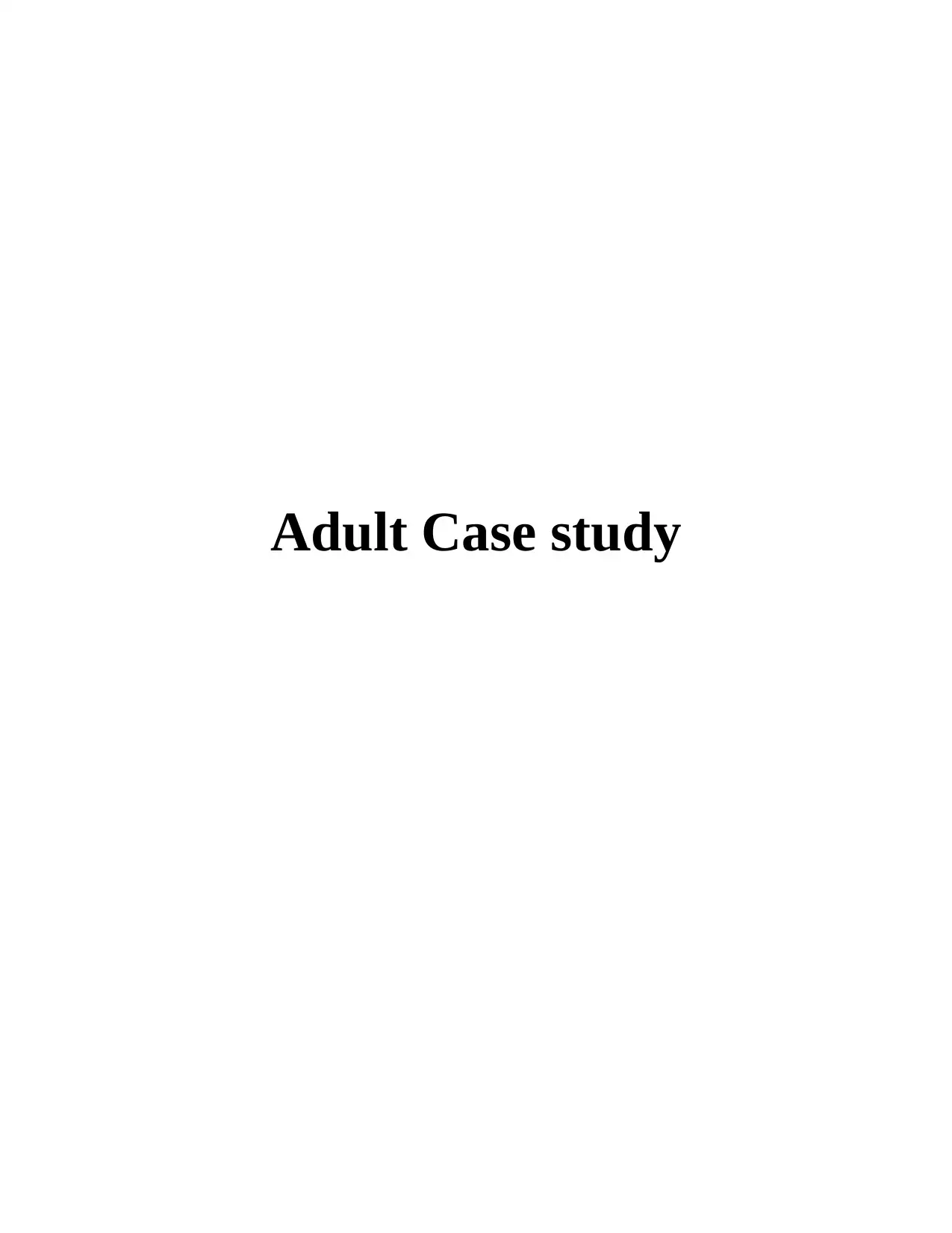
Adult Case study
Paraphrase This Document
Need a fresh take? Get an instant paraphrase of this document with our AI Paraphraser
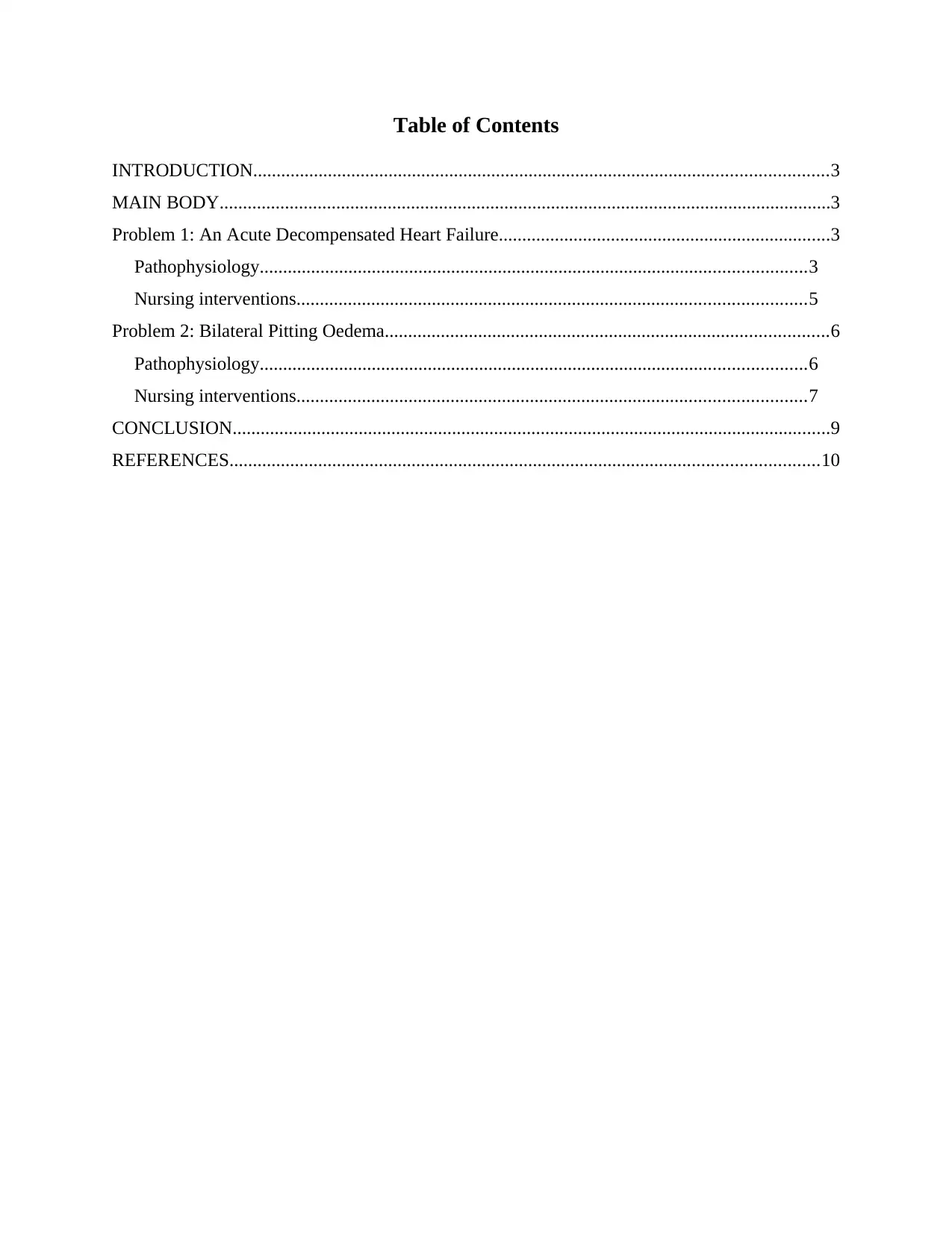
Table of Contents
INTRODUCTION...........................................................................................................................3
MAIN BODY...................................................................................................................................3
Problem 1: An Acute Decompensated Heart Failure.......................................................................3
Pathophysiology.....................................................................................................................3
Nursing interventions.............................................................................................................5
Problem 2: Bilateral Pitting Oedema...............................................................................................6
Pathophysiology.....................................................................................................................6
Nursing interventions.............................................................................................................7
CONCLUSION................................................................................................................................9
REFERENCES..............................................................................................................................10
INTRODUCTION...........................................................................................................................3
MAIN BODY...................................................................................................................................3
Problem 1: An Acute Decompensated Heart Failure.......................................................................3
Pathophysiology.....................................................................................................................3
Nursing interventions.............................................................................................................5
Problem 2: Bilateral Pitting Oedema...............................................................................................6
Pathophysiology.....................................................................................................................6
Nursing interventions.............................................................................................................7
CONCLUSION................................................................................................................................9
REFERENCES..............................................................................................................................10
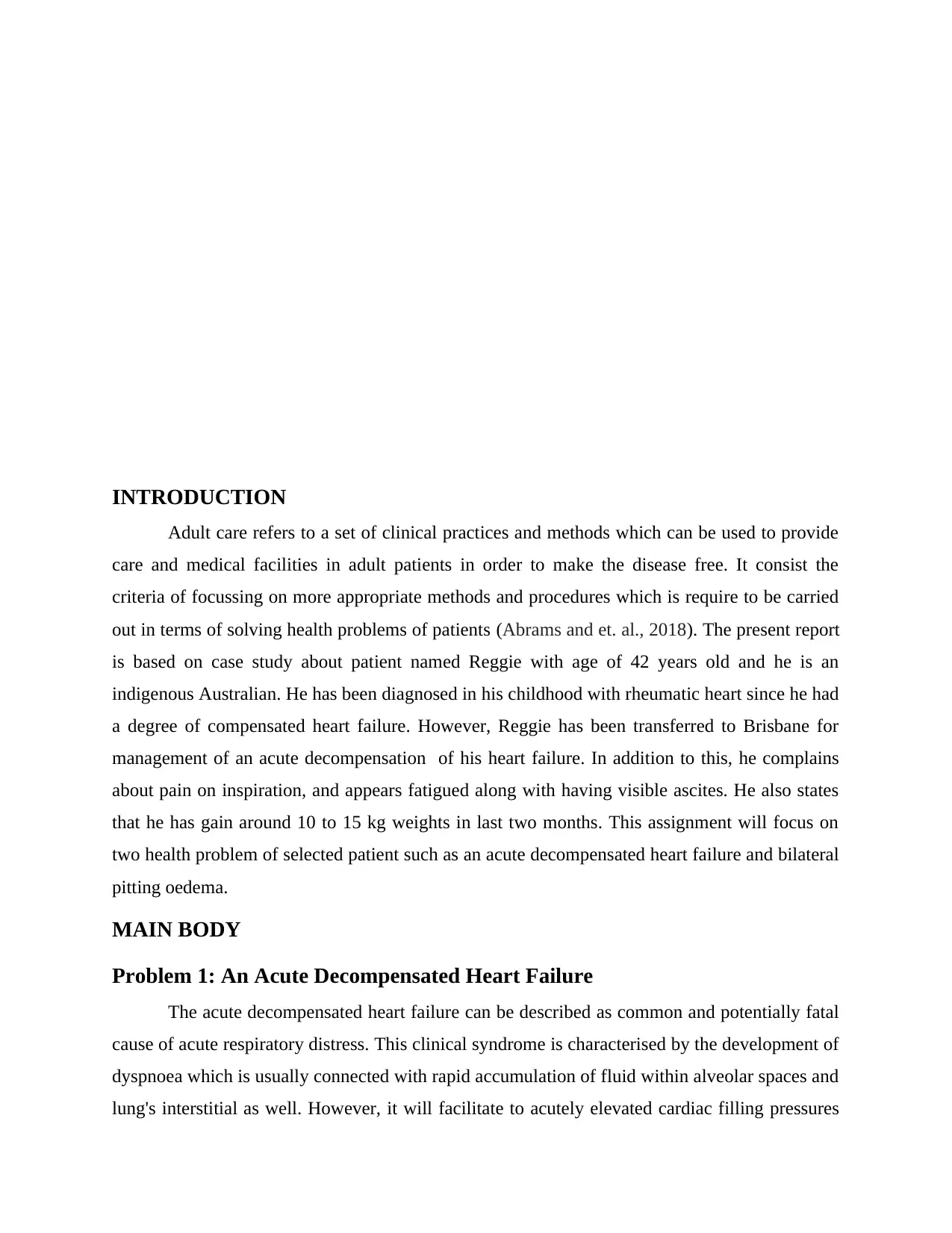
INTRODUCTION
Adult care refers to a set of clinical practices and methods which can be used to provide
care and medical facilities in adult patients in order to make the disease free. It consist the
criteria of focussing on more appropriate methods and procedures which is require to be carried
out in terms of solving health problems of patients (Abrams and et. al., 2018). The present report
is based on case study about patient named Reggie with age of 42 years old and he is an
indigenous Australian. He has been diagnosed in his childhood with rheumatic heart since he had
a degree of compensated heart failure. However, Reggie has been transferred to Brisbane for
management of an acute decompensation of his heart failure. In addition to this, he complains
about pain on inspiration, and appears fatigued along with having visible ascites. He also states
that he has gain around 10 to 15 kg weights in last two months. This assignment will focus on
two health problem of selected patient such as an acute decompensated heart failure and bilateral
pitting oedema.
MAIN BODY
Problem 1: An Acute Decompensated Heart Failure
The acute decompensated heart failure can be described as common and potentially fatal
cause of acute respiratory distress. This clinical syndrome is characterised by the development of
dyspnoea which is usually connected with rapid accumulation of fluid within alveolar spaces and
lung's interstitial as well. However, it will facilitate to acutely elevated cardiac filling pressures
Adult care refers to a set of clinical practices and methods which can be used to provide
care and medical facilities in adult patients in order to make the disease free. It consist the
criteria of focussing on more appropriate methods and procedures which is require to be carried
out in terms of solving health problems of patients (Abrams and et. al., 2018). The present report
is based on case study about patient named Reggie with age of 42 years old and he is an
indigenous Australian. He has been diagnosed in his childhood with rheumatic heart since he had
a degree of compensated heart failure. However, Reggie has been transferred to Brisbane for
management of an acute decompensation of his heart failure. In addition to this, he complains
about pain on inspiration, and appears fatigued along with having visible ascites. He also states
that he has gain around 10 to 15 kg weights in last two months. This assignment will focus on
two health problem of selected patient such as an acute decompensated heart failure and bilateral
pitting oedema.
MAIN BODY
Problem 1: An Acute Decompensated Heart Failure
The acute decompensated heart failure can be described as common and potentially fatal
cause of acute respiratory distress. This clinical syndrome is characterised by the development of
dyspnoea which is usually connected with rapid accumulation of fluid within alveolar spaces and
lung's interstitial as well. However, it will facilitate to acutely elevated cardiac filling pressures
⊘ This is a preview!⊘
Do you want full access?
Subscribe today to unlock all pages.

Trusted by 1+ million students worldwide
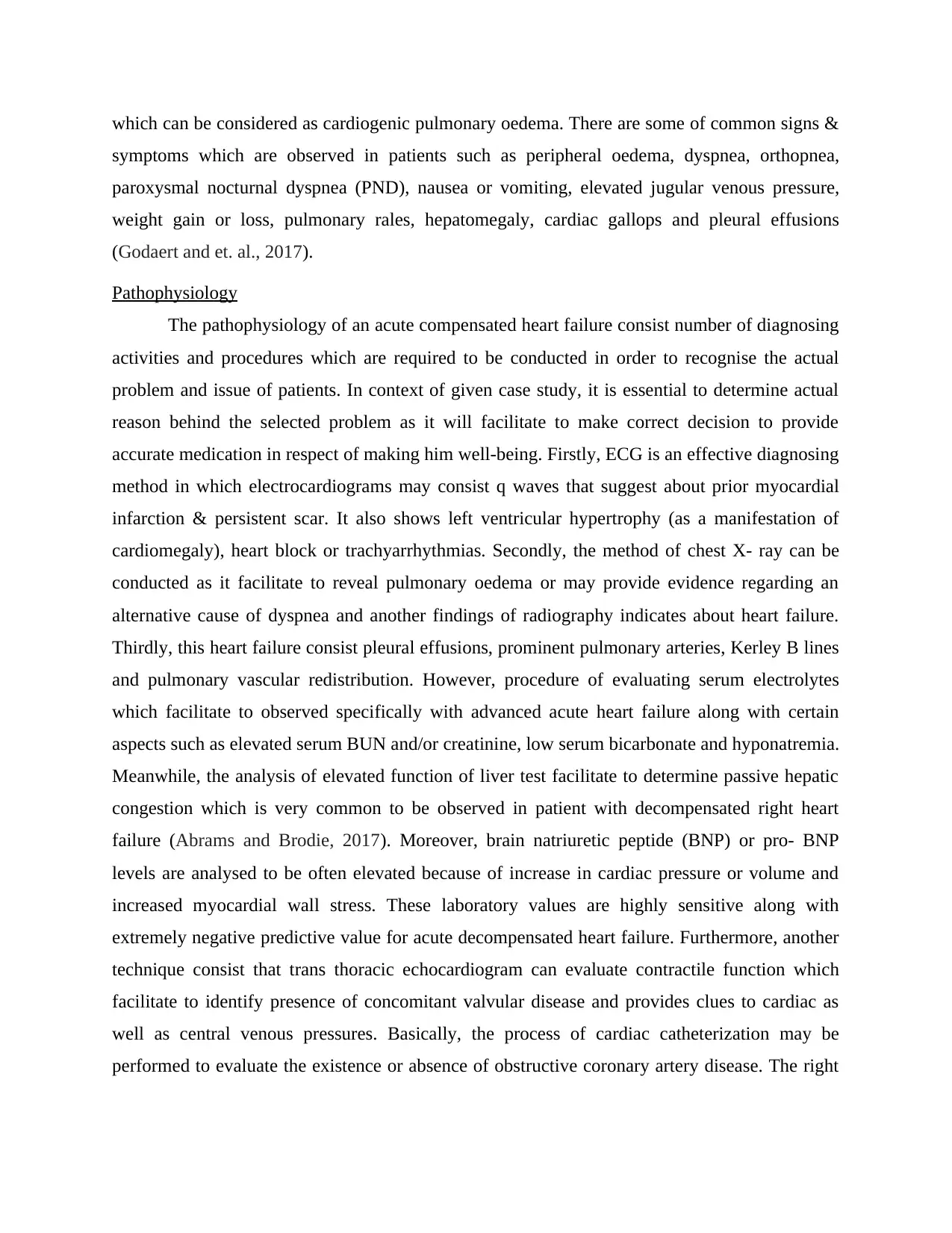
which can be considered as cardiogenic pulmonary oedema. There are some of common signs &
symptoms which are observed in patients such as peripheral oedema, dyspnea, orthopnea,
paroxysmal nocturnal dyspnea (PND), nausea or vomiting, elevated jugular venous pressure,
weight gain or loss, pulmonary rales, hepatomegaly, cardiac gallops and pleural effusions
(Godaert and et. al., 2017).
Pathophysiology
The pathophysiology of an acute compensated heart failure consist number of diagnosing
activities and procedures which are required to be conducted in order to recognise the actual
problem and issue of patients. In context of given case study, it is essential to determine actual
reason behind the selected problem as it will facilitate to make correct decision to provide
accurate medication in respect of making him well-being. Firstly, ECG is an effective diagnosing
method in which electrocardiograms may consist q waves that suggest about prior myocardial
infarction & persistent scar. It also shows left ventricular hypertrophy (as a manifestation of
cardiomegaly), heart block or trachyarrhythmias. Secondly, the method of chest X- ray can be
conducted as it facilitate to reveal pulmonary oedema or may provide evidence regarding an
alternative cause of dyspnea and another findings of radiography indicates about heart failure.
Thirdly, this heart failure consist pleural effusions, prominent pulmonary arteries, Kerley B lines
and pulmonary vascular redistribution. However, procedure of evaluating serum electrolytes
which facilitate to observed specifically with advanced acute heart failure along with certain
aspects such as elevated serum BUN and/or creatinine, low serum bicarbonate and hyponatremia.
Meanwhile, the analysis of elevated function of liver test facilitate to determine passive hepatic
congestion which is very common to be observed in patient with decompensated right heart
failure (Abrams and Brodie, 2017). Moreover, brain natriuretic peptide (BNP) or pro- BNP
levels are analysed to be often elevated because of increase in cardiac pressure or volume and
increased myocardial wall stress. These laboratory values are highly sensitive along with
extremely negative predictive value for acute decompensated heart failure. Furthermore, another
technique consist that trans thoracic echocardiogram can evaluate contractile function which
facilitate to identify presence of concomitant valvular disease and provides clues to cardiac as
well as central venous pressures. Basically, the process of cardiac catheterization may be
performed to evaluate the existence or absence of obstructive coronary artery disease. The right
symptoms which are observed in patients such as peripheral oedema, dyspnea, orthopnea,
paroxysmal nocturnal dyspnea (PND), nausea or vomiting, elevated jugular venous pressure,
weight gain or loss, pulmonary rales, hepatomegaly, cardiac gallops and pleural effusions
(Godaert and et. al., 2017).
Pathophysiology
The pathophysiology of an acute compensated heart failure consist number of diagnosing
activities and procedures which are required to be conducted in order to recognise the actual
problem and issue of patients. In context of given case study, it is essential to determine actual
reason behind the selected problem as it will facilitate to make correct decision to provide
accurate medication in respect of making him well-being. Firstly, ECG is an effective diagnosing
method in which electrocardiograms may consist q waves that suggest about prior myocardial
infarction & persistent scar. It also shows left ventricular hypertrophy (as a manifestation of
cardiomegaly), heart block or trachyarrhythmias. Secondly, the method of chest X- ray can be
conducted as it facilitate to reveal pulmonary oedema or may provide evidence regarding an
alternative cause of dyspnea and another findings of radiography indicates about heart failure.
Thirdly, this heart failure consist pleural effusions, prominent pulmonary arteries, Kerley B lines
and pulmonary vascular redistribution. However, procedure of evaluating serum electrolytes
which facilitate to observed specifically with advanced acute heart failure along with certain
aspects such as elevated serum BUN and/or creatinine, low serum bicarbonate and hyponatremia.
Meanwhile, the analysis of elevated function of liver test facilitate to determine passive hepatic
congestion which is very common to be observed in patient with decompensated right heart
failure (Abrams and Brodie, 2017). Moreover, brain natriuretic peptide (BNP) or pro- BNP
levels are analysed to be often elevated because of increase in cardiac pressure or volume and
increased myocardial wall stress. These laboratory values are highly sensitive along with
extremely negative predictive value for acute decompensated heart failure. Furthermore, another
technique consist that trans thoracic echocardiogram can evaluate contractile function which
facilitate to identify presence of concomitant valvular disease and provides clues to cardiac as
well as central venous pressures. Basically, the process of cardiac catheterization may be
performed to evaluate the existence or absence of obstructive coronary artery disease. The right
Paraphrase This Document
Need a fresh take? Get an instant paraphrase of this document with our AI Paraphraser
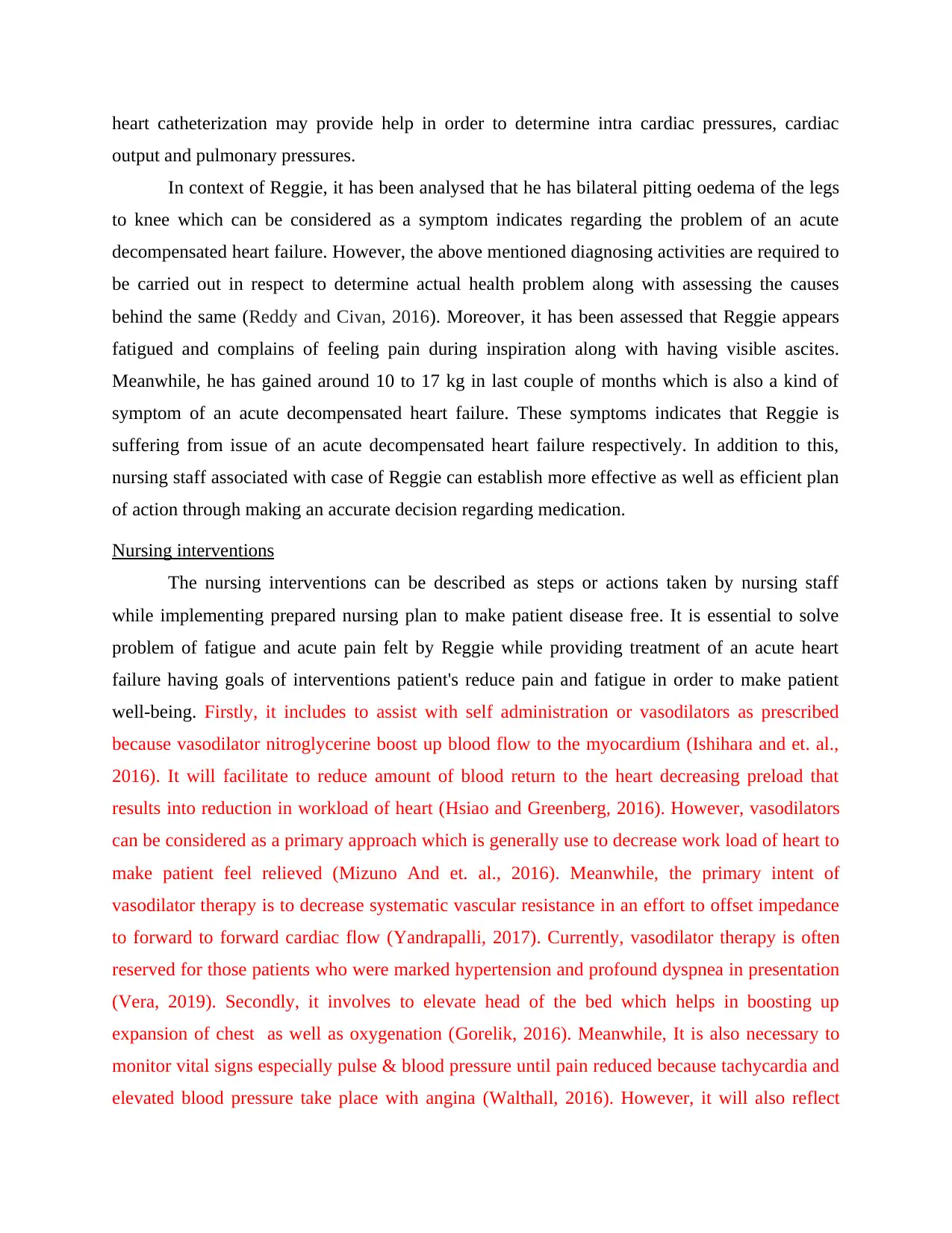
heart catheterization may provide help in order to determine intra cardiac pressures, cardiac
output and pulmonary pressures.
In context of Reggie, it has been analysed that he has bilateral pitting oedema of the legs
to knee which can be considered as a symptom indicates regarding the problem of an acute
decompensated heart failure. However, the above mentioned diagnosing activities are required to
be carried out in respect to determine actual health problem along with assessing the causes
behind the same (Reddy and Civan, 2016). Moreover, it has been assessed that Reggie appears
fatigued and complains of feeling pain during inspiration along with having visible ascites.
Meanwhile, he has gained around 10 to 17 kg in last couple of months which is also a kind of
symptom of an acute decompensated heart failure. These symptoms indicates that Reggie is
suffering from issue of an acute decompensated heart failure respectively. In addition to this,
nursing staff associated with case of Reggie can establish more effective as well as efficient plan
of action through making an accurate decision regarding medication.
Nursing interventions
The nursing interventions can be described as steps or actions taken by nursing staff
while implementing prepared nursing plan to make patient disease free. It is essential to solve
problem of fatigue and acute pain felt by Reggie while providing treatment of an acute heart
failure having goals of interventions patient's reduce pain and fatigue in order to make patient
well-being. Firstly, it includes to assist with self administration or vasodilators as prescribed
because vasodilator nitroglycerine boost up blood flow to the myocardium (Ishihara and et. al.,
2016). It will facilitate to reduce amount of blood return to the heart decreasing preload that
results into reduction in workload of heart (Hsiao and Greenberg, 2016). However, vasodilators
can be considered as a primary approach which is generally use to decrease work load of heart to
make patient feel relieved (Mizuno And et. al., 2016). Meanwhile, the primary intent of
vasodilator therapy is to decrease systematic vascular resistance in an effort to offset impedance
to forward to forward cardiac flow (Yandrapalli, 2017). Currently, vasodilator therapy is often
reserved for those patients who were marked hypertension and profound dyspnea in presentation
(Vera, 2019). Secondly, it involves to elevate head of the bed which helps in boosting up
expansion of chest as well as oxygenation (Gorelik, 2016). Meanwhile, It is also necessary to
monitor vital signs especially pulse & blood pressure until pain reduced because tachycardia and
elevated blood pressure take place with angina (Walthall, 2016). However, it will also reflect
output and pulmonary pressures.
In context of Reggie, it has been analysed that he has bilateral pitting oedema of the legs
to knee which can be considered as a symptom indicates regarding the problem of an acute
decompensated heart failure. However, the above mentioned diagnosing activities are required to
be carried out in respect to determine actual health problem along with assessing the causes
behind the same (Reddy and Civan, 2016). Moreover, it has been assessed that Reggie appears
fatigued and complains of feeling pain during inspiration along with having visible ascites.
Meanwhile, he has gained around 10 to 17 kg in last couple of months which is also a kind of
symptom of an acute decompensated heart failure. These symptoms indicates that Reggie is
suffering from issue of an acute decompensated heart failure respectively. In addition to this,
nursing staff associated with case of Reggie can establish more effective as well as efficient plan
of action through making an accurate decision regarding medication.
Nursing interventions
The nursing interventions can be described as steps or actions taken by nursing staff
while implementing prepared nursing plan to make patient disease free. It is essential to solve
problem of fatigue and acute pain felt by Reggie while providing treatment of an acute heart
failure having goals of interventions patient's reduce pain and fatigue in order to make patient
well-being. Firstly, it includes to assist with self administration or vasodilators as prescribed
because vasodilator nitroglycerine boost up blood flow to the myocardium (Ishihara and et. al.,
2016). It will facilitate to reduce amount of blood return to the heart decreasing preload that
results into reduction in workload of heart (Hsiao and Greenberg, 2016). However, vasodilators
can be considered as a primary approach which is generally use to decrease work load of heart to
make patient feel relieved (Mizuno And et. al., 2016). Meanwhile, the primary intent of
vasodilator therapy is to decrease systematic vascular resistance in an effort to offset impedance
to forward to forward cardiac flow (Yandrapalli, 2017). Currently, vasodilator therapy is often
reserved for those patients who were marked hypertension and profound dyspnea in presentation
(Vera, 2019). Secondly, it involves to elevate head of the bed which helps in boosting up
expansion of chest as well as oxygenation (Gorelik, 2016). Meanwhile, It is also necessary to
monitor vital signs especially pulse & blood pressure until pain reduced because tachycardia and
elevated blood pressure take place with angina (Walthall, 2016). However, it will also reflect
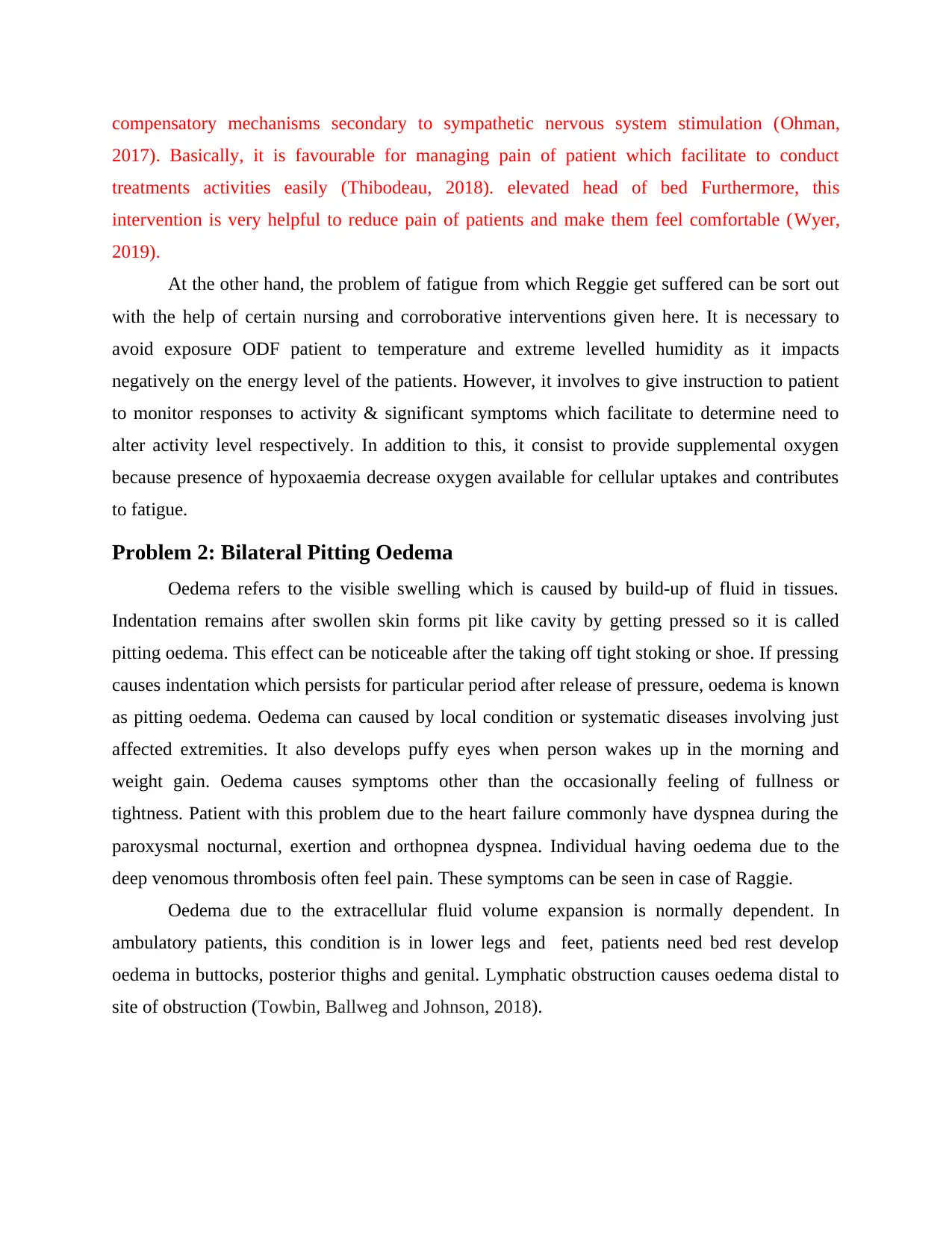
compensatory mechanisms secondary to sympathetic nervous system stimulation (Ohman,
2017). Basically, it is favourable for managing pain of patient which facilitate to conduct
treatments activities easily (Thibodeau, 2018). elevated head of bed Furthermore, this
intervention is very helpful to reduce pain of patients and make them feel comfortable (Wyer,
2019).
At the other hand, the problem of fatigue from which Reggie get suffered can be sort out
with the help of certain nursing and corroborative interventions given here. It is necessary to
avoid exposure ODF patient to temperature and extreme levelled humidity as it impacts
negatively on the energy level of the patients. However, it involves to give instruction to patient
to monitor responses to activity & significant symptoms which facilitate to determine need to
alter activity level respectively. In addition to this, it consist to provide supplemental oxygen
because presence of hypoxaemia decrease oxygen available for cellular uptakes and contributes
to fatigue.
Problem 2: Bilateral Pitting Oedema
Oedema refers to the visible swelling which is caused by build-up of fluid in tissues.
Indentation remains after swollen skin forms pit like cavity by getting pressed so it is called
pitting oedema. This effect can be noticeable after the taking off tight stoking or shoe. If pressing
causes indentation which persists for particular period after release of pressure, oedema is known
as pitting oedema. Oedema can caused by local condition or systematic diseases involving just
affected extremities. It also develops puffy eyes when person wakes up in the morning and
weight gain. Oedema causes symptoms other than the occasionally feeling of fullness or
tightness. Patient with this problem due to the heart failure commonly have dyspnea during the
paroxysmal nocturnal, exertion and orthopnea dyspnea. Individual having oedema due to the
deep venomous thrombosis often feel pain. These symptoms can be seen in case of Raggie.
Oedema due to the extracellular fluid volume expansion is normally dependent. In
ambulatory patients, this condition is in lower legs and feet, patients need bed rest develop
oedema in buttocks, posterior thighs and genital. Lymphatic obstruction causes oedema distal to
site of obstruction (Towbin, Ballweg and Johnson, 2018).
2017). Basically, it is favourable for managing pain of patient which facilitate to conduct
treatments activities easily (Thibodeau, 2018). elevated head of bed Furthermore, this
intervention is very helpful to reduce pain of patients and make them feel comfortable (Wyer,
2019).
At the other hand, the problem of fatigue from which Reggie get suffered can be sort out
with the help of certain nursing and corroborative interventions given here. It is necessary to
avoid exposure ODF patient to temperature and extreme levelled humidity as it impacts
negatively on the energy level of the patients. However, it involves to give instruction to patient
to monitor responses to activity & significant symptoms which facilitate to determine need to
alter activity level respectively. In addition to this, it consist to provide supplemental oxygen
because presence of hypoxaemia decrease oxygen available for cellular uptakes and contributes
to fatigue.
Problem 2: Bilateral Pitting Oedema
Oedema refers to the visible swelling which is caused by build-up of fluid in tissues.
Indentation remains after swollen skin forms pit like cavity by getting pressed so it is called
pitting oedema. This effect can be noticeable after the taking off tight stoking or shoe. If pressing
causes indentation which persists for particular period after release of pressure, oedema is known
as pitting oedema. Oedema can caused by local condition or systematic diseases involving just
affected extremities. It also develops puffy eyes when person wakes up in the morning and
weight gain. Oedema causes symptoms other than the occasionally feeling of fullness or
tightness. Patient with this problem due to the heart failure commonly have dyspnea during the
paroxysmal nocturnal, exertion and orthopnea dyspnea. Individual having oedema due to the
deep venomous thrombosis often feel pain. These symptoms can be seen in case of Raggie.
Oedema due to the extracellular fluid volume expansion is normally dependent. In
ambulatory patients, this condition is in lower legs and feet, patients need bed rest develop
oedema in buttocks, posterior thighs and genital. Lymphatic obstruction causes oedema distal to
site of obstruction (Towbin, Ballweg and Johnson, 2018).
⊘ This is a preview!⊘
Do you want full access?
Subscribe today to unlock all pages.

Trusted by 1+ million students worldwide
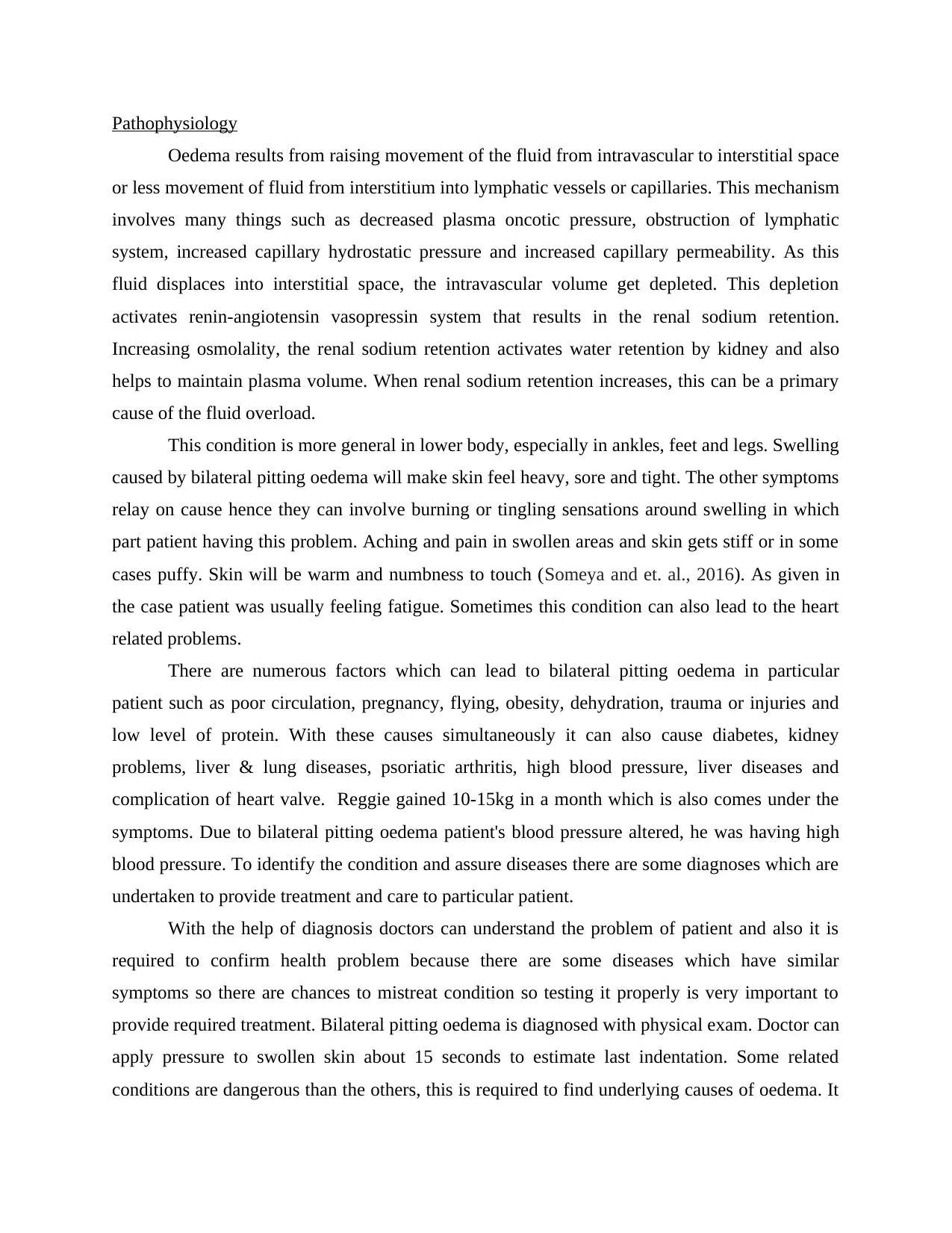
Pathophysiology
Oedema results from raising movement of the fluid from intravascular to interstitial space
or less movement of fluid from interstitium into lymphatic vessels or capillaries. This mechanism
involves many things such as decreased plasma oncotic pressure, obstruction of lymphatic
system, increased capillary hydrostatic pressure and increased capillary permeability. As this
fluid displaces into interstitial space, the intravascular volume get depleted. This depletion
activates renin-angiotensin vasopressin system that results in the renal sodium retention.
Increasing osmolality, the renal sodium retention activates water retention by kidney and also
helps to maintain plasma volume. When renal sodium retention increases, this can be a primary
cause of the fluid overload.
This condition is more general in lower body, especially in ankles, feet and legs. Swelling
caused by bilateral pitting oedema will make skin feel heavy, sore and tight. The other symptoms
relay on cause hence they can involve burning or tingling sensations around swelling in which
part patient having this problem. Aching and pain in swollen areas and skin gets stiff or in some
cases puffy. Skin will be warm and numbness to touch (Someya and et. al., 2016). As given in
the case patient was usually feeling fatigue. Sometimes this condition can also lead to the heart
related problems.
There are numerous factors which can lead to bilateral pitting oedema in particular
patient such as poor circulation, pregnancy, flying, obesity, dehydration, trauma or injuries and
low level of protein. With these causes simultaneously it can also cause diabetes, kidney
problems, liver & lung diseases, psoriatic arthritis, high blood pressure, liver diseases and
complication of heart valve. Reggie gained 10-15kg in a month which is also comes under the
symptoms. Due to bilateral pitting oedema patient's blood pressure altered, he was having high
blood pressure. To identify the condition and assure diseases there are some diagnoses which are
undertaken to provide treatment and care to particular patient.
With the help of diagnosis doctors can understand the problem of patient and also it is
required to confirm health problem because there are some diseases which have similar
symptoms so there are chances to mistreat condition so testing it properly is very important to
provide required treatment. Bilateral pitting oedema is diagnosed with physical exam. Doctor can
apply pressure to swollen skin about 15 seconds to estimate last indentation. Some related
conditions are dangerous than the others, this is required to find underlying causes of oedema. It
Oedema results from raising movement of the fluid from intravascular to interstitial space
or less movement of fluid from interstitium into lymphatic vessels or capillaries. This mechanism
involves many things such as decreased plasma oncotic pressure, obstruction of lymphatic
system, increased capillary hydrostatic pressure and increased capillary permeability. As this
fluid displaces into interstitial space, the intravascular volume get depleted. This depletion
activates renin-angiotensin vasopressin system that results in the renal sodium retention.
Increasing osmolality, the renal sodium retention activates water retention by kidney and also
helps to maintain plasma volume. When renal sodium retention increases, this can be a primary
cause of the fluid overload.
This condition is more general in lower body, especially in ankles, feet and legs. Swelling
caused by bilateral pitting oedema will make skin feel heavy, sore and tight. The other symptoms
relay on cause hence they can involve burning or tingling sensations around swelling in which
part patient having this problem. Aching and pain in swollen areas and skin gets stiff or in some
cases puffy. Skin will be warm and numbness to touch (Someya and et. al., 2016). As given in
the case patient was usually feeling fatigue. Sometimes this condition can also lead to the heart
related problems.
There are numerous factors which can lead to bilateral pitting oedema in particular
patient such as poor circulation, pregnancy, flying, obesity, dehydration, trauma or injuries and
low level of protein. With these causes simultaneously it can also cause diabetes, kidney
problems, liver & lung diseases, psoriatic arthritis, high blood pressure, liver diseases and
complication of heart valve. Reggie gained 10-15kg in a month which is also comes under the
symptoms. Due to bilateral pitting oedema patient's blood pressure altered, he was having high
blood pressure. To identify the condition and assure diseases there are some diagnoses which are
undertaken to provide treatment and care to particular patient.
With the help of diagnosis doctors can understand the problem of patient and also it is
required to confirm health problem because there are some diseases which have similar
symptoms so there are chances to mistreat condition so testing it properly is very important to
provide required treatment. Bilateral pitting oedema is diagnosed with physical exam. Doctor can
apply pressure to swollen skin about 15 seconds to estimate last indentation. Some related
conditions are dangerous than the others, this is required to find underlying causes of oedema. It
Paraphrase This Document
Need a fresh take? Get an instant paraphrase of this document with our AI Paraphraser
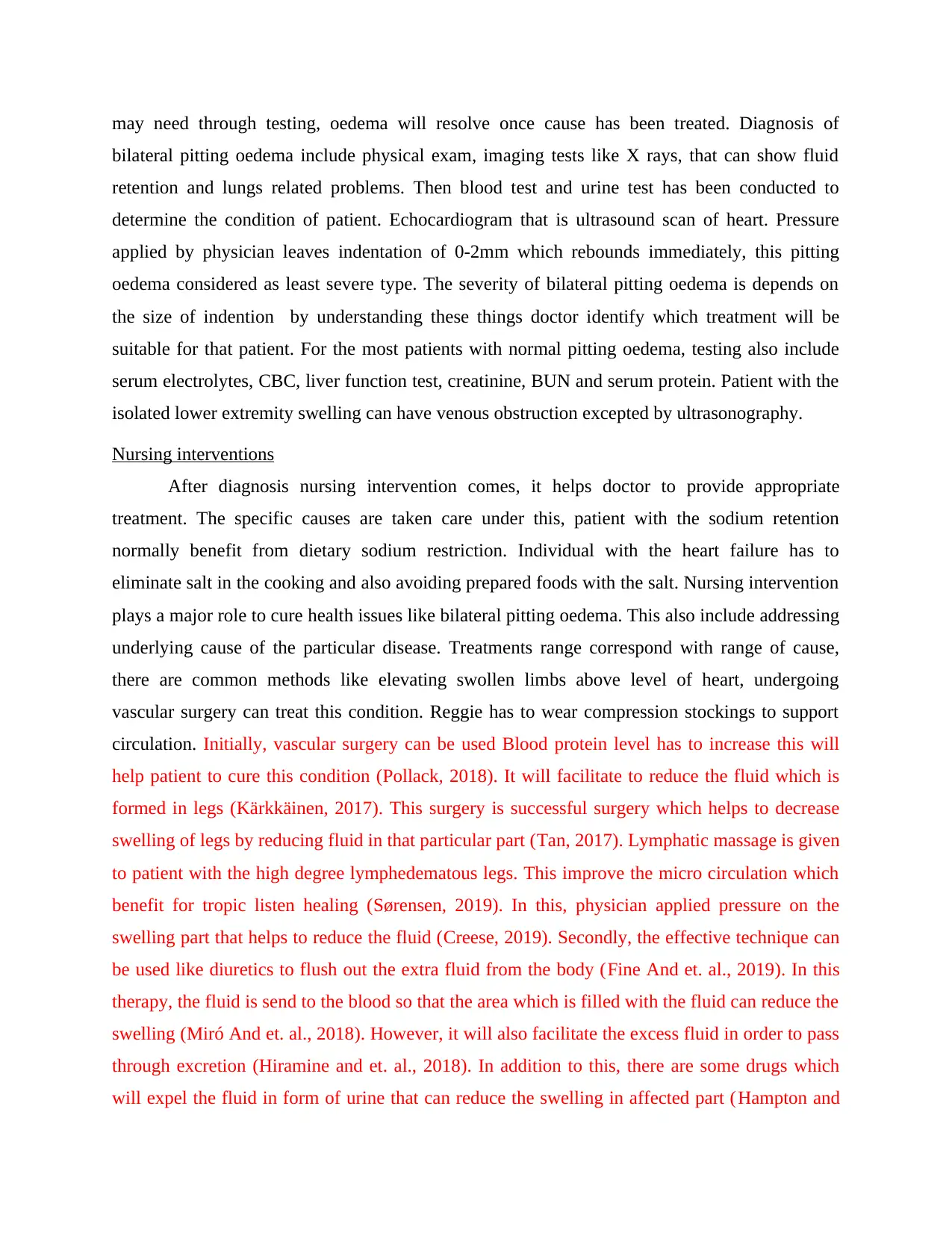
may need through testing, oedema will resolve once cause has been treated. Diagnosis of
bilateral pitting oedema include physical exam, imaging tests like X rays, that can show fluid
retention and lungs related problems. Then blood test and urine test has been conducted to
determine the condition of patient. Echocardiogram that is ultrasound scan of heart. Pressure
applied by physician leaves indentation of 0-2mm which rebounds immediately, this pitting
oedema considered as least severe type. The severity of bilateral pitting oedema is depends on
the size of indention by understanding these things doctor identify which treatment will be
suitable for that patient. For the most patients with normal pitting oedema, testing also include
serum electrolytes, CBC, liver function test, creatinine, BUN and serum protein. Patient with the
isolated lower extremity swelling can have venous obstruction excepted by ultrasonography.
Nursing interventions
After diagnosis nursing intervention comes, it helps doctor to provide appropriate
treatment. The specific causes are taken care under this, patient with the sodium retention
normally benefit from dietary sodium restriction. Individual with the heart failure has to
eliminate salt in the cooking and also avoiding prepared foods with the salt. Nursing intervention
plays a major role to cure health issues like bilateral pitting oedema. This also include addressing
underlying cause of the particular disease. Treatments range correspond with range of cause,
there are common methods like elevating swollen limbs above level of heart, undergoing
vascular surgery can treat this condition. Reggie has to wear compression stockings to support
circulation. Initially, vascular surgery can be used Blood protein level has to increase this will
help patient to cure this condition (Pollack, 2018). It will facilitate to reduce the fluid which is
formed in legs (Kärkkäinen, 2017). This surgery is successful surgery which helps to decrease
swelling of legs by reducing fluid in that particular part (Tan, 2017). Lymphatic massage is given
to patient with the high degree lymphedematous legs. This improve the micro circulation which
benefit for tropic listen healing (Sørensen, 2019). In this, physician applied pressure on the
swelling part that helps to reduce the fluid (Creese, 2019). Secondly, the effective technique can
be used like diuretics to flush out the extra fluid from the body (Fine And et. al., 2019). In this
therapy, the fluid is send to the blood so that the area which is filled with the fluid can reduce the
swelling (Miró And et. al., 2018). However, it will also facilitate the excess fluid in order to pass
through excretion (Hiramine and et. al., 2018). In addition to this, there are some drugs which
will expel the fluid in form of urine that can reduce the swelling in affected part (Hampton and
bilateral pitting oedema include physical exam, imaging tests like X rays, that can show fluid
retention and lungs related problems. Then blood test and urine test has been conducted to
determine the condition of patient. Echocardiogram that is ultrasound scan of heart. Pressure
applied by physician leaves indentation of 0-2mm which rebounds immediately, this pitting
oedema considered as least severe type. The severity of bilateral pitting oedema is depends on
the size of indention by understanding these things doctor identify which treatment will be
suitable for that patient. For the most patients with normal pitting oedema, testing also include
serum electrolytes, CBC, liver function test, creatinine, BUN and serum protein. Patient with the
isolated lower extremity swelling can have venous obstruction excepted by ultrasonography.
Nursing interventions
After diagnosis nursing intervention comes, it helps doctor to provide appropriate
treatment. The specific causes are taken care under this, patient with the sodium retention
normally benefit from dietary sodium restriction. Individual with the heart failure has to
eliminate salt in the cooking and also avoiding prepared foods with the salt. Nursing intervention
plays a major role to cure health issues like bilateral pitting oedema. This also include addressing
underlying cause of the particular disease. Treatments range correspond with range of cause,
there are common methods like elevating swollen limbs above level of heart, undergoing
vascular surgery can treat this condition. Reggie has to wear compression stockings to support
circulation. Initially, vascular surgery can be used Blood protein level has to increase this will
help patient to cure this condition (Pollack, 2018). It will facilitate to reduce the fluid which is
formed in legs (Kärkkäinen, 2017). This surgery is successful surgery which helps to decrease
swelling of legs by reducing fluid in that particular part (Tan, 2017). Lymphatic massage is given
to patient with the high degree lymphedematous legs. This improve the micro circulation which
benefit for tropic listen healing (Sørensen, 2019). In this, physician applied pressure on the
swelling part that helps to reduce the fluid (Creese, 2019). Secondly, the effective technique can
be used like diuretics to flush out the extra fluid from the body (Fine And et. al., 2019). In this
therapy, the fluid is send to the blood so that the area which is filled with the fluid can reduce the
swelling (Miró And et. al., 2018). However, it will also facilitate the excess fluid in order to pass
through excretion (Hiramine and et. al., 2018). In addition to this, there are some drugs which
will expel the fluid in form of urine that can reduce the swelling in affected part (Hampton and
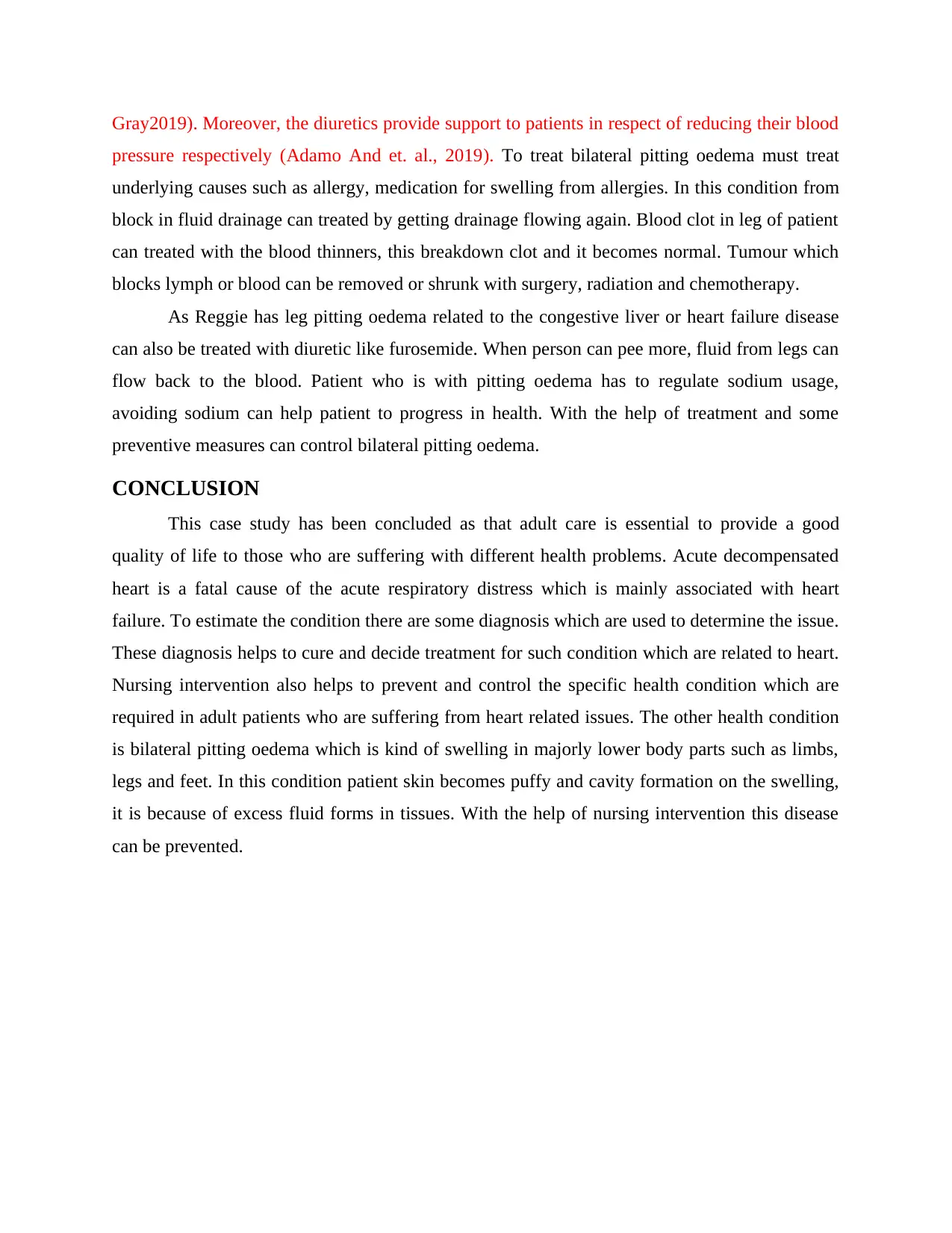
Gray2019). Moreover, the diuretics provide support to patients in respect of reducing their blood
pressure respectively (Adamo And et. al., 2019). To treat bilateral pitting oedema must treat
underlying causes such as allergy, medication for swelling from allergies. In this condition from
block in fluid drainage can treated by getting drainage flowing again. Blood clot in leg of patient
can treated with the blood thinners, this breakdown clot and it becomes normal. Tumour which
blocks lymph or blood can be removed or shrunk with surgery, radiation and chemotherapy.
As Reggie has leg pitting oedema related to the congestive liver or heart failure disease
can also be treated with diuretic like furosemide. When person can pee more, fluid from legs can
flow back to the blood. Patient who is with pitting oedema has to regulate sodium usage,
avoiding sodium can help patient to progress in health. With the help of treatment and some
preventive measures can control bilateral pitting oedema.
CONCLUSION
This case study has been concluded as that adult care is essential to provide a good
quality of life to those who are suffering with different health problems. Acute decompensated
heart is a fatal cause of the acute respiratory distress which is mainly associated with heart
failure. To estimate the condition there are some diagnosis which are used to determine the issue.
These diagnosis helps to cure and decide treatment for such condition which are related to heart.
Nursing intervention also helps to prevent and control the specific health condition which are
required in adult patients who are suffering from heart related issues. The other health condition
is bilateral pitting oedema which is kind of swelling in majorly lower body parts such as limbs,
legs and feet. In this condition patient skin becomes puffy and cavity formation on the swelling,
it is because of excess fluid forms in tissues. With the help of nursing intervention this disease
can be prevented.
pressure respectively (Adamo And et. al., 2019). To treat bilateral pitting oedema must treat
underlying causes such as allergy, medication for swelling from allergies. In this condition from
block in fluid drainage can treated by getting drainage flowing again. Blood clot in leg of patient
can treated with the blood thinners, this breakdown clot and it becomes normal. Tumour which
blocks lymph or blood can be removed or shrunk with surgery, radiation and chemotherapy.
As Reggie has leg pitting oedema related to the congestive liver or heart failure disease
can also be treated with diuretic like furosemide. When person can pee more, fluid from legs can
flow back to the blood. Patient who is with pitting oedema has to regulate sodium usage,
avoiding sodium can help patient to progress in health. With the help of treatment and some
preventive measures can control bilateral pitting oedema.
CONCLUSION
This case study has been concluded as that adult care is essential to provide a good
quality of life to those who are suffering with different health problems. Acute decompensated
heart is a fatal cause of the acute respiratory distress which is mainly associated with heart
failure. To estimate the condition there are some diagnosis which are used to determine the issue.
These diagnosis helps to cure and decide treatment for such condition which are related to heart.
Nursing intervention also helps to prevent and control the specific health condition which are
required in adult patients who are suffering from heart related issues. The other health condition
is bilateral pitting oedema which is kind of swelling in majorly lower body parts such as limbs,
legs and feet. In this condition patient skin becomes puffy and cavity formation on the swelling,
it is because of excess fluid forms in tissues. With the help of nursing intervention this disease
can be prevented.
⊘ This is a preview!⊘
Do you want full access?
Subscribe today to unlock all pages.

Trusted by 1+ million students worldwide
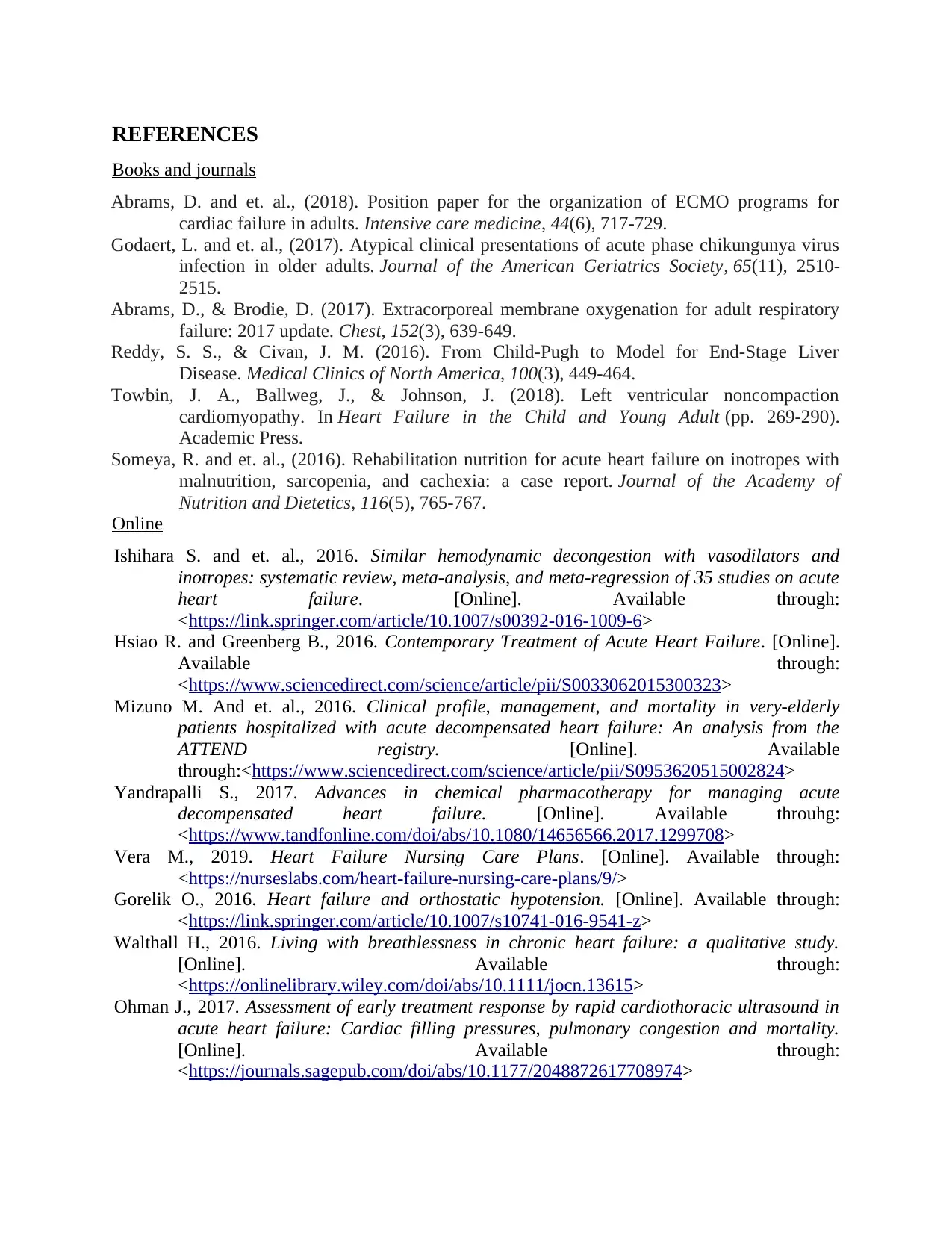
REFERENCES
Books and journals
Abrams, D. and et. al., (2018). Position paper for the organization of ECMO programs for
cardiac failure in adults. Intensive care medicine, 44(6), 717-729.
Godaert, L. and et. al., (2017). Atypical clinical presentations of acute phase chikungunya virus
infection in older adults. Journal of the American Geriatrics Society, 65(11), 2510-
2515.
Abrams, D., & Brodie, D. (2017). Extracorporeal membrane oxygenation for adult respiratory
failure: 2017 update. Chest, 152(3), 639-649.
Reddy, S. S., & Civan, J. M. (2016). From Child-Pugh to Model for End-Stage Liver
Disease. Medical Clinics of North America, 100(3), 449-464.
Towbin, J. A., Ballweg, J., & Johnson, J. (2018). Left ventricular noncompaction
cardiomyopathy. In Heart Failure in the Child and Young Adult (pp. 269-290).
Academic Press.
Someya, R. and et. al., (2016). Rehabilitation nutrition for acute heart failure on inotropes with
malnutrition, sarcopenia, and cachexia: a case report. Journal of the Academy of
Nutrition and Dietetics, 116(5), 765-767.
Online
Ishihara S. and et. al., 2016. Similar hemodynamic decongestion with vasodilators and
inotropes: systematic review, meta-analysis, and meta-regression of 35 studies on acute
heart failure. [Online]. Available through:
<https://link.springer.com/article/10.1007/s00392-016-1009-6>
Hsiao R. and Greenberg B., 2016. Contemporary Treatment of Acute Heart Failure. [Online].
Available through:
<https://www.sciencedirect.com/science/article/pii/S0033062015300323>
Mizuno M. And et. al., 2016. Clinical profile, management, and mortality in very-elderly
patients hospitalized with acute decompensated heart failure: An analysis from the
ATTEND registry. [Online]. Available
through:<https://www.sciencedirect.com/science/article/pii/S0953620515002824>
Yandrapalli S., 2017. Advances in chemical pharmacotherapy for managing acute
decompensated heart failure. [Online]. Available throuhg:
<https://www.tandfonline.com/doi/abs/10.1080/14656566.2017.1299708>
Vera M., 2019. Heart Failure Nursing Care Plans. [Online]. Available through:
<https://nurseslabs.com/heart-failure-nursing-care-plans/9/>
Gorelik O., 2016. Heart failure and orthostatic hypotension. [Online]. Available through:
<https://link.springer.com/article/10.1007/s10741-016-9541-z>
Walthall H., 2016. Living with breathlessness in chronic heart failure: a qualitative study.
[Online]. Available through:
<https://onlinelibrary.wiley.com/doi/abs/10.1111/jocn.13615>
Ohman J., 2017. Assessment of early treatment response by rapid cardiothoracic ultrasound in
acute heart failure: Cardiac filling pressures, pulmonary congestion and mortality.
[Online]. Available through:
<https://journals.sagepub.com/doi/abs/10.1177/2048872617708974>
Books and journals
Abrams, D. and et. al., (2018). Position paper for the organization of ECMO programs for
cardiac failure in adults. Intensive care medicine, 44(6), 717-729.
Godaert, L. and et. al., (2017). Atypical clinical presentations of acute phase chikungunya virus
infection in older adults. Journal of the American Geriatrics Society, 65(11), 2510-
2515.
Abrams, D., & Brodie, D. (2017). Extracorporeal membrane oxygenation for adult respiratory
failure: 2017 update. Chest, 152(3), 639-649.
Reddy, S. S., & Civan, J. M. (2016). From Child-Pugh to Model for End-Stage Liver
Disease. Medical Clinics of North America, 100(3), 449-464.
Towbin, J. A., Ballweg, J., & Johnson, J. (2018). Left ventricular noncompaction
cardiomyopathy. In Heart Failure in the Child and Young Adult (pp. 269-290).
Academic Press.
Someya, R. and et. al., (2016). Rehabilitation nutrition for acute heart failure on inotropes with
malnutrition, sarcopenia, and cachexia: a case report. Journal of the Academy of
Nutrition and Dietetics, 116(5), 765-767.
Online
Ishihara S. and et. al., 2016. Similar hemodynamic decongestion with vasodilators and
inotropes: systematic review, meta-analysis, and meta-regression of 35 studies on acute
heart failure. [Online]. Available through:
<https://link.springer.com/article/10.1007/s00392-016-1009-6>
Hsiao R. and Greenberg B., 2016. Contemporary Treatment of Acute Heart Failure. [Online].
Available through:
<https://www.sciencedirect.com/science/article/pii/S0033062015300323>
Mizuno M. And et. al., 2016. Clinical profile, management, and mortality in very-elderly
patients hospitalized with acute decompensated heart failure: An analysis from the
ATTEND registry. [Online]. Available
through:<https://www.sciencedirect.com/science/article/pii/S0953620515002824>
Yandrapalli S., 2017. Advances in chemical pharmacotherapy for managing acute
decompensated heart failure. [Online]. Available throuhg:
<https://www.tandfonline.com/doi/abs/10.1080/14656566.2017.1299708>
Vera M., 2019. Heart Failure Nursing Care Plans. [Online]. Available through:
<https://nurseslabs.com/heart-failure-nursing-care-plans/9/>
Gorelik O., 2016. Heart failure and orthostatic hypotension. [Online]. Available through:
<https://link.springer.com/article/10.1007/s10741-016-9541-z>
Walthall H., 2016. Living with breathlessness in chronic heart failure: a qualitative study.
[Online]. Available through:
<https://onlinelibrary.wiley.com/doi/abs/10.1111/jocn.13615>
Ohman J., 2017. Assessment of early treatment response by rapid cardiothoracic ultrasound in
acute heart failure: Cardiac filling pressures, pulmonary congestion and mortality.
[Online]. Available through:
<https://journals.sagepub.com/doi/abs/10.1177/2048872617708974>
Paraphrase This Document
Need a fresh take? Get an instant paraphrase of this document with our AI Paraphraser
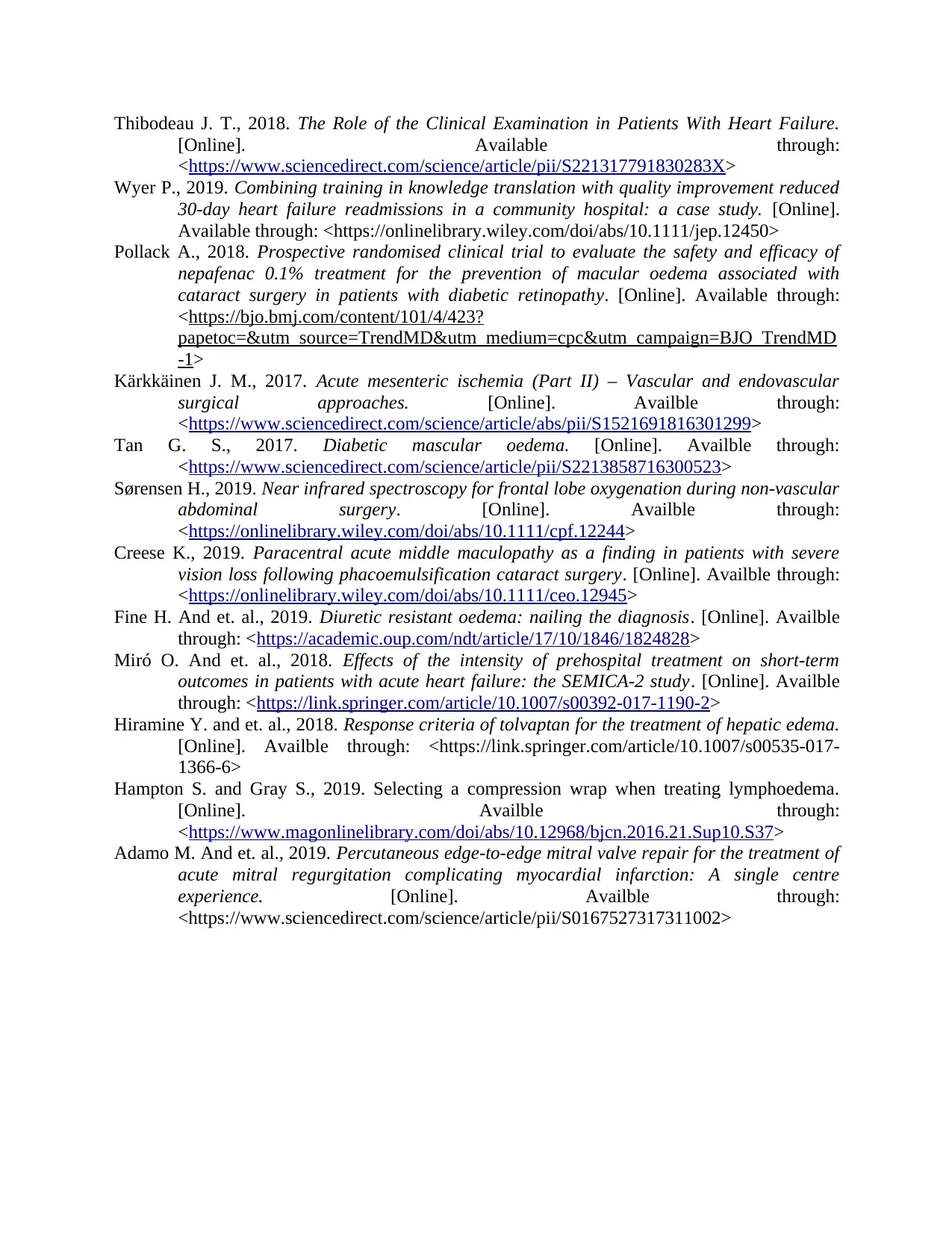
Thibodeau J. T., 2018. The Role of the Clinical Examination in Patients With Heart Failure.
[Online]. Available through:
<https://www.sciencedirect.com/science/article/pii/S221317791830283X>
Wyer P., 2019. Combining training in knowledge translation with quality improvement reduced
30‐day heart failure readmissions in a community hospital: a case study. [Online].
Available through: <https://onlinelibrary.wiley.com/doi/abs/10.1111/jep.12450>
Pollack A., 2018. Prospective randomised clinical trial to evaluate the safety and efficacy of
nepafenac 0.1% treatment for the prevention of macular oedema associated with
cataract surgery in patients with diabetic retinopathy. [Online]. Available through:
<https://bjo.bmj.com/content/101/4/423?
papetoc=&utm_source=TrendMD&utm_medium=cpc&utm_campaign=BJO_TrendMD
-1>
Kärkkäinen J. M., 2017. Acute mesenteric ischemia (Part II) – Vascular and endovascular
surgical approaches. [Online]. Availble through:
<https://www.sciencedirect.com/science/article/abs/pii/S1521691816301299>
Tan G. S., 2017. Diabetic mascular oedema. [Online]. Availble through:
<https://www.sciencedirect.com/science/article/pii/S2213858716300523>
Sørensen H., 2019. Near infrared spectroscopy for frontal lobe oxygenation during non‐vascular
abdominal surgery. [Online]. Availble through:
<https://onlinelibrary.wiley.com/doi/abs/10.1111/cpf.12244>
Creese K., 2019. Paracentral acute middle maculopathy as a finding in patients with severe
vision loss following phacoemulsification cataract surgery. [Online]. Availble through:
<https://onlinelibrary.wiley.com/doi/abs/10.1111/ceo.12945>
Fine H. And et. al., 2019. Diuretic resistant oedema: nailing the diagnosis. [Online]. Availble
through: <https://academic.oup.com/ndt/article/17/10/1846/1824828>
Miró O. And et. al., 2018. Effects of the intensity of prehospital treatment on short-term
outcomes in patients with acute heart failure: the SEMICA-2 study. [Online]. Availble
through: <https://link.springer.com/article/10.1007/s00392-017-1190-2>
Hiramine Y. and et. al., 2018. Response criteria of tolvaptan for the treatment of hepatic edema.
[Online]. Availble through: <https://link.springer.com/article/10.1007/s00535-017-
1366-6>
Hampton S. and Gray S., 2019. Selecting a compression wrap when treating lymphoedema.
[Online]. Availble through:
<https://www.magonlinelibrary.com/doi/abs/10.12968/bjcn.2016.21.Sup10.S37>
Adamo M. And et. al., 2019. Percutaneous edge-to-edge mitral valve repair for the treatment of
acute mitral regurgitation complicating myocardial infarction: A single centre
experience. [Online]. Availble through:
<https://www.sciencedirect.com/science/article/pii/S0167527317311002>
[Online]. Available through:
<https://www.sciencedirect.com/science/article/pii/S221317791830283X>
Wyer P., 2019. Combining training in knowledge translation with quality improvement reduced
30‐day heart failure readmissions in a community hospital: a case study. [Online].
Available through: <https://onlinelibrary.wiley.com/doi/abs/10.1111/jep.12450>
Pollack A., 2018. Prospective randomised clinical trial to evaluate the safety and efficacy of
nepafenac 0.1% treatment for the prevention of macular oedema associated with
cataract surgery in patients with diabetic retinopathy. [Online]. Available through:
<https://bjo.bmj.com/content/101/4/423?
papetoc=&utm_source=TrendMD&utm_medium=cpc&utm_campaign=BJO_TrendMD
-1>
Kärkkäinen J. M., 2017. Acute mesenteric ischemia (Part II) – Vascular and endovascular
surgical approaches. [Online]. Availble through:
<https://www.sciencedirect.com/science/article/abs/pii/S1521691816301299>
Tan G. S., 2017. Diabetic mascular oedema. [Online]. Availble through:
<https://www.sciencedirect.com/science/article/pii/S2213858716300523>
Sørensen H., 2019. Near infrared spectroscopy for frontal lobe oxygenation during non‐vascular
abdominal surgery. [Online]. Availble through:
<https://onlinelibrary.wiley.com/doi/abs/10.1111/cpf.12244>
Creese K., 2019. Paracentral acute middle maculopathy as a finding in patients with severe
vision loss following phacoemulsification cataract surgery. [Online]. Availble through:
<https://onlinelibrary.wiley.com/doi/abs/10.1111/ceo.12945>
Fine H. And et. al., 2019. Diuretic resistant oedema: nailing the diagnosis. [Online]. Availble
through: <https://academic.oup.com/ndt/article/17/10/1846/1824828>
Miró O. And et. al., 2018. Effects of the intensity of prehospital treatment on short-term
outcomes in patients with acute heart failure: the SEMICA-2 study. [Online]. Availble
through: <https://link.springer.com/article/10.1007/s00392-017-1190-2>
Hiramine Y. and et. al., 2018. Response criteria of tolvaptan for the treatment of hepatic edema.
[Online]. Availble through: <https://link.springer.com/article/10.1007/s00535-017-
1366-6>
Hampton S. and Gray S., 2019. Selecting a compression wrap when treating lymphoedema.
[Online]. Availble through:
<https://www.magonlinelibrary.com/doi/abs/10.12968/bjcn.2016.21.Sup10.S37>
Adamo M. And et. al., 2019. Percutaneous edge-to-edge mitral valve repair for the treatment of
acute mitral regurgitation complicating myocardial infarction: A single centre
experience. [Online]. Availble through:
<https://www.sciencedirect.com/science/article/pii/S0167527317311002>

⊘ This is a preview!⊘
Do you want full access?
Subscribe today to unlock all pages.

Trusted by 1+ million students worldwide
1 out of 12
Related Documents
Your All-in-One AI-Powered Toolkit for Academic Success.
+13062052269
info@desklib.com
Available 24*7 on WhatsApp / Email
![[object Object]](/_next/static/media/star-bottom.7253800d.svg)
Unlock your academic potential
Copyright © 2020–2025 A2Z Services. All Rights Reserved. Developed and managed by ZUCOL.





